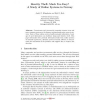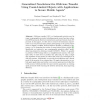FC
2008
Springer
14 years 4 months ago
2008
Springer
FC
2008
Springer
14 years 4 months ago
2008
Springer
Abstract. We consider general secure function evaluation (SFE) of private functions (PF-SFE). Recall, privacy of functions is often most efficiently achieved by general SFE [18,19,...
FC
2008
Springer
14 years 4 months ago
2008
Springer
This paper presents fair traceable multi-group signatures (FTMGS), which have enhanced capabilities, compared to group and traceable signatures, that are important in real world sc...
FC
2008
Springer
14 years 4 months ago
2008
Springer
FC
2008
Springer
14 years 4 months ago
2008
Springer
Abstract. The banking industry in Norway has developed a new security infrastructure for conducting commerce on the Internet. The initiative, called BankID, aims to become a nation...
FC
2008
Springer
14 years 4 months ago
2008
Springer
Governments and commercial companies connect more and more computer systems to the Internet, giving people easier access to services. Many of these online services handle personal ...
FC
2008
Springer
14 years 4 months ago
2008
Springer
Abstract. An economic model of the online advertising market is presented, focusing on the effect of ad fraud. In the model, the market is comprised of three classes of players: pu...
FC
2008
Springer
14 years 4 months ago
2008
Springer
In this paper, we present some guidelines for implementing various financial instruments for the purposes of credit and payment, including protocols for commercial transactions, di...
FC
2008
Springer
14 years 4 months ago
2008
Springer
Abstract. Physical cash is vulnerable to rising threats, such as large-scale, government-mandated forgeries, that digital cash may protect against more effectively. We study mechan...
FC
2008
Springer
14 years 4 months ago
2008
Springer
Oblivious transfer (OT) is a fundamental primitive used in many cryptographic protocols, including general secure function evaluation (SFE) protocols. However, interaction is a pri...





